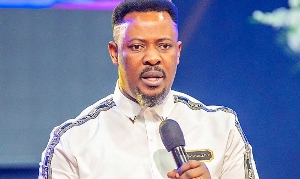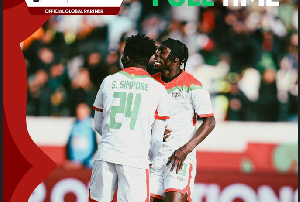by King Kove Jr.,
A recent article written by Larweh Therson-Cofie titled “Age of Orwellian Journalism”, which appeared in the Daily Graphic of Thursday, 7th October, 2010 and the New Weekend Crusading Guide on Friday, 8th October, 2010 raised some concerns on the practice of journalism in the face of detective techniques used by undercover reporter Anas Aremeyaw Anas in his journalistic work. The writer presents an argument on the ethics and challenges of the reporter’s work, but simplifies the complexities which underlie the practice of undercover journalism.
The article was very successful in leading the way on public commentary regarding what people should expect and demand from the press. It was stimulating, particularly in the light of recent global debates of what journalism really is and how it can be used to benefit society. There was however, an apparent lack of equilibrium on some points made by the writer in the article, thereby begging the question of what the title suggests.
First, the basic premise of the article is that “journalism is a conservative profession”, one that shares the same conservatism “as the other cardinal professions such as law, medicine, engineering, architecture, pharmacy and religion”. Therson-Cofie adds, “The principles of a cardinal profession scarcely accommodate drastic changes. Principles can be modified here and there once in a while but the basic or fundamental ones which form the core or foundation of the profession remain the same”.
Although the article did not dwell on the principles of the listed professions that remain “conservative” in spite of “drastic changes”, basic understanding of these professions renders the premise a bit facile, particularly with the placement of journalism on the list. There were key points which the article failed to address in support of its analysis.
In the listed professions, Medicine may have its basic principle as the need to save lives and not kill – a reason why bedside manners by medical practitioners is still required in spite of technological advances in medicine. The same can be said about architecture, where the implementation of the architecture, establishing the key tenets and related guidance for designing and developing structures hold sway.
In the case of Law and Religion, the point can be made that principles and guidelines, intended to be enduring and seldom amended, inform and support the way these professions reach their goals. In this light, the place of journalism on the list can only be justified when we make reference to its foremost principle that demands an obligation to the truth. That aside, journalism appears awkward on that list.
In the age of citizen journalism, flexibility and agility would be an asset for the best in journalism. These days, the journalist’s role as prime mover is lost – a sobering reminder that the journalist’s role has been shifted from the “cardinal professions”. We can scarcely imagine citizen architects, citizen doctors or citizen lawyers as we now have in journalism. This is a fact that the writer of the article failed to point out, one that is critical to understanding the true nature of journalism. Journalism can never be as conservative as Medicine, Law or Architecture.
In examining the work of the undercover journalist, the article makes reference to a publication in a newspaper that provided a prelude to the latest work by the journalist on the Osu Children’s Home. The publication in question headlined its story “Anas drops atomic “bomb”, in which the story is told of how the journalist visited the orphanage to plant 45 micro-cameras within the home and also wired himself as a priest for the subterfuge. The article thus notes: “The spy-journalist’s style of news gathering raises many questions. How many of the tools [he] used are journalistic tools? How many of his news gathering techniques are journalistic? How much of his report aired on television is drama? How much of it is spying? And how much of it is journalism?”
Trying to answer these questions would be merely theoretical, since they demand answers that lie outside a third party’s grasp. However, a look at the life and works of an undercover journalist provides a clue to what the rules of the game should be; and knowing that Anas Aremeyaw Anas claims the title of an undercover reporter, it is fair to relate this to his works.
For one, the title undercover journalist sends strong signals to the world that such a person belongs to a tradition that is more complicated and dynamic than what “Age of Orwellian Journalism” suggests.
This kind of journalism has few specific predecessors, among them PrimeTime Live’s Food lion investigation in the United States, BBC’s Panorama, 60 minutes, 20/20 and Dateline NBC. In Ghana, Anas Aremeyaw Anas appears to be the pioneer of this kind of journalism, which makes him the bearer of the loads that come with Pioneering. Anas’ journalism is a niche-concern, with many underlying risks for the practitioner. As a result, he is seen as a reporter of “last resorts”, when it comes to gathering journalistic information.
While there are, appropriately, no hard-and-fast rules or central authorities for journalism, the Poynter Institute of resource for journalism located in St. Petersburg, Florida., adopted some criteria as ethics for undercover journalists. Two overriding guidelines state that deception and hidden cameras may be appropriate: a) when the information obtained is of profound importance. It must be of vital public interest, such as revealing great “system failure” at the top levels, or it must prevent profound harm to individuals b) when all other alternatives for obtaining the same information have been exhausted.
Going by this, it is within the confines of fairness to ask whether the undercover journalist in question played by these rules. Clearly, deciding that the issues at the Osu Children Home warranted undercover treatment is a reflection of editorial judgment, which Anas discussed extensively since the story broke. Much has already been said about the documentations which were made available to authorities charged with manning the home about the deaths, neglect, solitary confinement of kids and many other abuses long before the documentary was produced. In effect, the journalist only acted when those charged with managing the place refused to act. This, puts the case presented in “Age of Orwellian Journalism”, that authorities should have been given “the knowledge that he was gathering information about them” a non-starter. It takes the discussion to the outer fringes of balanced analysis.
In the concluding paragraph, Therson-Cofie writes, “To discourage spy or detective journalism, the Ghana Journalists Association must not give recognition or award prizes to investigative journalists who employ unorthodox methods such as spying techniques to obtain information”.
This suggestion brings into focus, the standards prescribed by the Ghana Journalists Association for its membership, to which Anas belongs. An outstanding clause, which is often used to justify undercover journalism, is “the public interest”. The second part of Article 5 of the GJA’s code of ethics states: “Enquiries and intrusions into a person’s private life can only be justified when done in the public interest”. Public interest gives an eye view into the malleable nature of what informs journalistic practices.
When it comes to public interest, it is a matter of judgment for both journalists and their audience. Could the undercover journalist have exposed the ills of the Home without applying the means he used? This is the point of the great ethical dilemma in journalism, which brings many journalists to the crossroads. To resort to name calling at this stage is misleading, because the ethical dilemma is one that is usually resolved based on the many complexities that a journalist faces in breaking the story. At this stage, journalism is defined by the realities of society rather than the playbooks of the trade. Suggesting conservatism in a profession that prides itself with transforming society by seeking the truth is engendering the pervasive politics that has strangled our key institutions over the years.
At the risk of being labeled a supporter of a particular kind of journalism, a point can be made that the style being led by Anas in Ghana currently can be seen in many ways as a tribute to our society, a society where key stakeholders always call on reporters and whistleblowers to back their reports with evidence, a society where distrust is so pervasive that reporters’ notebooks and recorded voices are not enough as evidence. When video evidence is seen as “stage-managed”, we can hardly fault the healers for providing the proverbial “extreme remedy for the extreme disease”.
The concept of “Orwellian Journalism” draws from the term Orwellian, which “connotes an attitude and a policy of control by propaganda, surveillance, misinformation, denial of truth and manipulation [practiced by modern repressive governments]”. George Orwell’s book, Nineteen Eighty-Four, gives meaning to the term as an invasion of personal privacy, either directly or through surveillance”.
The points raised in Age of Orwellian Journalism failed to give context to the invasion of privacy it suggests. Legal interpretations of privacy clearly hold that public personages are not protected in many situations, since their activities are of legitimate interest to the public. The same can be said about public places such as the Osu Children Home, where certain illegal practices such as detention of minors in the Remand Home without court orders took place. In the court of law, privacy is not guaranteed to participants in a criminal offence; and since the story was about children who could do nothing about the situation, it is clear that the reporter’s work transcends the idea of “bringing Ghanaians close to that weird world” suggested in the article. Labeling such work as “Orwellian” deflects its significance.
Opinions of Wednesday, 13 October 2010
Columnist: Kove, King
RE: Age Of Orwellian Journalism
Entertainment













